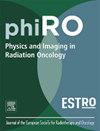基于直接磁共振成像的脑肿瘤质子剂量计算的概念验证研究,通过具有蒙特卡罗可比精度的神经网络
IF 3.3
Q2 ONCOLOGY
引用次数: 0
摘要
背景和目的质子治疗目前依赖于计算机断层扫描(CT)成像,尽管磁共振成像(MRI)具有优越的软组织对比。虽然合成ct可以由磁共振(MR)图像生成,但这引入了额外的复杂性。我们提出了一种基于深度学习的剂量引擎,能够从MR图像中直接计算质子剂量,以简化工作流程,同时保持蒙特卡罗(MC)级别的准确性。材料和方法使用39例脑肿瘤患者的配对MR-CT扫描(29/3/7用于训练/验证/测试),我们开发了一个使用各种序列模型的深度学习框架,用于单个质子铅笔束剂量预测。该框架处理来自每位患者2000个随机光束配置的束眼视图贴片,其角度和能量各不相同,并在CT上预先计算相应的MC剂量分布。使用CT图像训练模型进行比较。结果在评估的序列模型中,xLSTM架构在MR和基于ct的场景中表现最好。对于完整的治疗方案,我们的模型实现了伽马通过率中位数为99.8%(范围:98.6% - 99.9%,1 mm/1%),患者体内剂量误差中位数为0.2%(范围:0.1% - 0.4%),高剂量区域(处方剂量>; 90%)剂量误差中位数为1.3%(范围:0.8% - 3.7%)。该模型每束预测只需3毫秒,而MC模拟需要2秒。结论本研究证明了直接从脑肿瘤患者的MR图像中计算mc质量质子剂量的可行性,计算速度更快,实现简化,具有相当的准确性。本文章由计算机程序翻译,如有差异,请以英文原文为准。
A proof-of-concept study of direct magnetic resonance imaging-based proton dose calculation for brain tumors via neural networks with Monte Carlo-comparable accuracy
Background and purpose
Proton therapy currently relies on computed tomography (CT) imaging despite magnetic resonance imaging’s (MRI) superior soft-tissue contrast. While synthetic CTs can be generated from magnetic resonance (MR) images, this introduces additional complexity. We present a deep learning-based dose engine enabling direct proton dose calculation from MR images to streamline workflows while maintaining Monte Carlo (MC)-level accuracy.
Materials and methods
Using paired MR-CT scans from 39 brain tumor patients (29/3/7 for training/validation/testing), we developed a deep learning framework using various sequence models for individual proton pencil beam dose prediction. The framework processes beam-eye-view patches from 2000 random beam configurations per patient, varying in angles and energy, with corresponding MC dose distributions pre-calculated on CT. Models using CT images were trained for comparison.
Results
The xLSTM architecture performed best for both MR and CT-based scenarios among the evaluated sequence models. For full treatment plans, our model achieved gamma pass rates with median 99.8 % (range: 98.6 %–99.9 %, 1 mm/1%), and median percentage dose errors of 0.2 % (range: 0.1 %–0.4 %) within patient bodies and 1.3 % (range: 0.8 %–3.7 %) in high-dose regions (>90 % prescription dose). The model required only 3 ms per beam prediction compared to 2 s for MC simulation.
Conclusion
This study demonstrated the feasibility of MC-quality proton dose calculations directly from MR images for brain tumor patients, achieving comparable accuracy with faster computation and simplified implementation.
求助全文
通过发布文献求助,成功后即可免费获取论文全文。
去求助
来源期刊

Physics and Imaging in Radiation Oncology
Physics and Astronomy-Radiation
CiteScore
5.30
自引率
18.90%
发文量
93
审稿时长
6 weeks
 求助内容:
求助内容: 应助结果提醒方式:
应助结果提醒方式:


